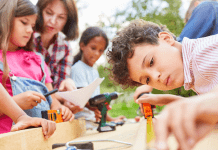
At some point in the parenting journey, we have to prepare for “the talk.” Girls and boys begin to realize that they have different parts. Those parts have different functions. And some of them need to be kept private. So, when is the right time to have a discussion about the birds and bees, and how explicit do we have to get?
Whether we are focusing on sex or babies, it all makes many parents feel uneasy. Talking about it with our kids is intimidating and worrying. You may not be sure how to talk with your child about his or her body. You may be hesitant to even bring up the subject. You may even wonder if you should wait until it is taught in school.
You may also question whether holding back is the answer. Kids are kids. They’re going to ask questions. What are you supposed to say when your curious young child asks: “Mom, dad, where do babies come from?”
“If you can relate to these concerns, you’re not alone,” says Karen Wilson, MD, a pediatrician at Scripps Clinic Carmel Valley, who speaks to many families about how to broach the subject of the birds and the bees with their children.
“With a few basic guidelines, you’ll find it is easier than you may have thought to discuss these topics,” Dr. Wilson says. “Moreover, you’re establishing a foundation for open, honest communication with your kids in the years ahead.”
Initiating a Sensitive Conversation
Dr. Wilson recommends starting teaching kids about their bodies at age four or five. “Many parents are startled to learn that these conversations should begin at such a young age. However, the earlier you start the easier it will be.”
Research has shown us that children at this age have a very healthy curiosity about how their bodies work. As a result, this may be the most comfortable time to initiate the conversation.
“This is a conversation every family should have at home,” Dr. Wilson explains. “Don’t wait for your children to learn it in school or from their friends. By the time sexual education is covered in school, most kids have already heard plenty of misinformation in the playground.”
Start early with conversations at home, Dr. Wilson advises. “Not only will you be setting them straight from the start, you’ll teach your kids to come to you when they have questions or want more information.”
Developing an Approach for Discussion
So how do you bring up the subject? One way is to take advantage of “teachable moments.” These are events in our everyday lives that open the doors to initiating conversation.
For example, if your daughter sees a baby boy’s diaper being changed, or your son notices differences between his body and his sister’s, you can start to talk about parts of the body and how boys and girls are different. (And please, don’t worry that if you talk to your kids about their sexuality, they will go out and experiment. This has not proven to be true).
Also, parents should not be afraid to teach their children the correct names for body parts from the start; for example, “penis” instead of a childish nickname.
Why? For one, this eliminates confusion that can occur when a child has learned a nickname for a body part and then learns there is another (and correct) name for it later. Also, learning the proper names encourages children to view their body parts with healthy respect, and helps them feel more comfortable about discussing their bodies.
Make it a point to teach children which body parts are private. One simple way is to explain that their private parts are the ones covered by their bathing suit.
“Explain to your kids that it is not okay for anyone else to see or touch their private parts,” Dr. Wilson says. “Let them know that if someone does try to touch their private parts, they need to tell someone.”
While a “trusted adult” is a common choice, many young children may not understand that concept. Sadly, a “trusted adult” may have been the one who tried to touch them. “Reassure your child that he or she can tell you anything, no matter what,” Dr. Wilson says. “Or, designate a family member or friend to be the person that your child should go to if anything happens.”
Myths & Misinformation
Unfortunately, it is common for kids to get the wrong information from their friends at school or the soccer field. Say your child comes home and shares some inaccurate news he or she heard about where babies come from. Don’t panic.
“First, ask where they heard the information and who else knows this, so that you can alert other families if necessary. Second, ask what they think about what they heard. This gives them a chance to explain what they understood and opens the door for you to initiate further conversation and share the facts.”
If what your child heard is correct but goes against your family values, let him or her know that your family does not agree. This is a good opportunity to help instill your family’s principles and morals in your child.
Above all, you want to teach children a healthy appreciation for their bodies and build a foundation for ongoing dialogue in the future.
Photo Credit: Bruno Nascimento
About Scripps Health
Scripps Health is a leading private, non-profit, integrated health system in San Diego, Calif., that treats more than 700,000 patients every year.
With five hospital campuses across San Diego County, along with our many outpatient centers, walk-in clinics, emergency rooms, urgent care sites, home-based healthcare and more, we’re dedicated to delivering excellent care whenever and wherever it’s needed. Whether you’re looking for some of the best doctors in San Diego or need care at one of the nation’s best hospitals ranked by U.S. News & World Report (https://www.scripps.org/news_items/6752-u-s-news-ranks-scripps-hospitals-no-1-in-san-diego-region), Scripps offers excellent medical care as well as preventive services and wellness screenings for every stage of life.


















